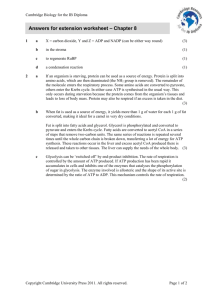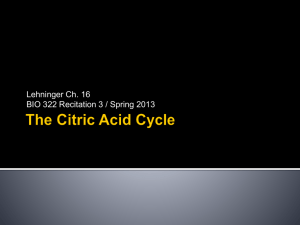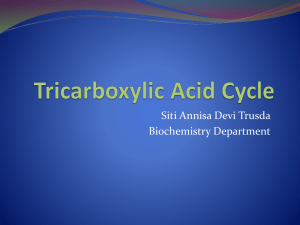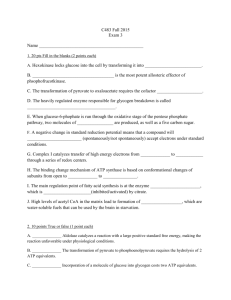Review session for exam-I
advertisement
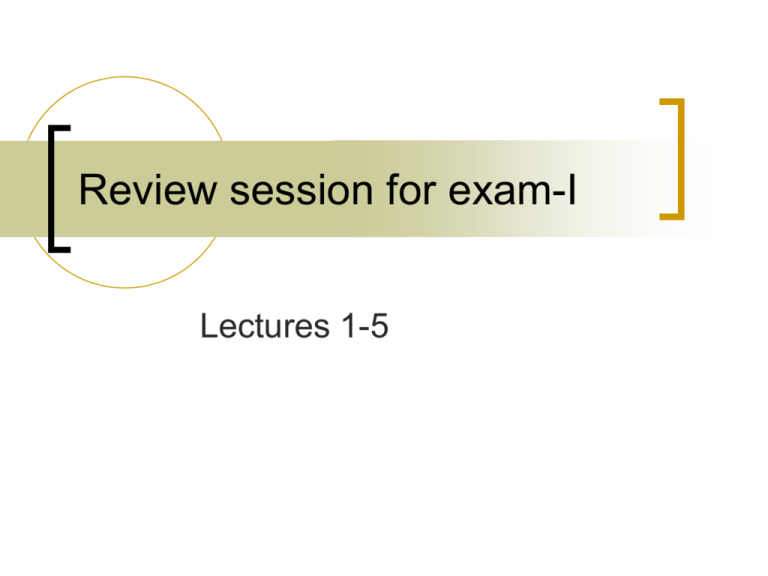
Review session for exam-I Lectures 1-5 Q1. Carbohydrates are a) b) c) d) e) polyhydroxy aldehydes. polyhydroxy ketones. polyhydroxy acids. polyhydroxy alcohols. a and b. Q2. The simplest carbohydrates are a) b) c) d) D- and L-glyceraldehyde. dihydroxyacetone and glycerate. All of the above. None of the above. Q3. An aldehyde and an alcohol can react to form a a) b) c) d) e) hemiaketal. hemiketal. hemiacetal. All of the above. None of the above. Q4. Sugars are commonly linked to which amino acid residues in glycoproteins? a) b) c) d) e) tyrosine and asparagine serine, threonine, and asparagine serine, tyrosine, and asparagine serine and threonine a and d Q5. Draw the Fischer projection structures of glucose. Q6. Identify the monosaccharides involved and the type of linkage in lactose? Q7. What is the standard-state free energy (ΔG°′) for the hydrolysis of ATP to ADP? a) b) c) d) e) +45.6 kJ/mol. 45.6 kJ/mol. -30.5 kJ/mol.(-7.3 kcal/mol) -15.6 kJ/mol. +30.5 kJ/mol. Q8. Reaction pathways that transform fuels into cellular energy are a) b) c) d) e) anabolic catabolic allobolic All of the above. None of the above. Q9. Which of the following molecule(s) have a higher phosphoryl-transfer potential than ATP? a) phosphoenolpyruvate b) creatine phosphate c) 1,3-bisphosphoglycerate d) a and b e) a, b, and c Q10. The reduced form of flavin adenine dinucleotide is a) b) c) d) e) FADH. FAD. FADH2+. FADH2. None of the above. Q11. What two 3-carbon molecules are generated by the cleavage of fructose-1,6-bisphosphate? a) glyceraldehyde-3-phosphate and 3phosphoglycerate b) glyceraldehyde-3-phosphate and dihydroxyacetone phosphate c) pyruvate and phosphoenolpyruvate d) enolase and 2-phosphoglycerate e) glyceraldehyde-3-phosphate and pyruvate Q12. What is the function of glyceraldehyde 3-phosphate dehydrogenase? a) oxidation by NAD+ and formation of acylphosphate b) oxidation of the alcohol to an aldehyde c) dehydration and dephosphorylation of GAP d) hydrolysis of GAP e) None of the above. Q13. What is substrate level phosphorylation? a) phosphorylation of AMP by ATP b) ATP synthesis when the phosphate donor is a substrate with high phosphoryl transfer potential c) phosphorylation of glycolytic intermediates d) phosphorylation of ATP coupled to an ion gradient e) ATP and AMP synthesis from two molecules of ADP Q14. Which of the following is an example of an oxidation reaction? a) b) c) . . . - O2C CH2 CH2 CO2 CO2C C + FADH2 O2C H H + FAD O O CH3CCO2- - O2CCH2CCO2- + ADP + Pi + CO2 + ATP CO2- CO2H2N C H H C NH2 CH3 CH3 d) Ala-Ser + H2O → Ala + Ser e) None of the above. Q15. What are the primary metabolic fates of pyruvate? a) b) c) d) e) ethanol lactate acetyl CoA All of the above. None of the above. Q16. Lactose intolerance is caused by a deficiency of a) b) c) d) e) lactase elastase lactose sucrase None of the above. Q17. Both hexokinase and glucokinase phosphorylate glucose. The function of glucokinase is to phosphorylate glucose in liver cells as a means to regulate blood-sugar levels. Would you expect its Km to be higher or lower than hexokinase? Q18. What is the biochemical explanation for galactosemia? Q19. Starting with Fructose 1,6 –Bisphosphate, how many ATP’s are made until the production of pyruvate? Q20. For each molecule of glucose converted to pyruvate in the glycolytic pathway, ___ molecules of ATP are used initially (Phase I) and ____ molecules of ATP are produced (Phase II) for an overall yield of ___ molecules of ATP/glucose. The "ATP math" is: a) b) c) d) e) 2+4=2 1+4=3 -2 + 5 = 3 -1 + 2 = 1 2+2=4 Q21. Glycolysis in the erythrocyte produces pyruvate that is further metabolized to: Q22. An enzyme in glycolysis that catalyzes a reversible reaction and generates a high-energy bond is a) Hexokinase b) Pyruvate c) kinase Phosphofructokinase d) Glyceraldehyde 3-phosphate dehydrogenase Q23. After complete metabolism of one molecule of glucose to carbon dioxide via the TCA cycle, what will be the net change in the amount of oxaloacetate in the mitochondrion? a) b) c) d) e) Increased by two molecules Increased by one molecule Unchanged Decreased by one molecule Decreased by two molecules Q24. An abnormal accumulation of galactose 1-P in the liver would be caused by the deficiency of a) glucose 6-phosphate dehydrogenase. b) glucose 6-phosphatase. c) galactokinase. d) galactose 1-phosphate uridylyl transferase. e) hexokinase. Q25. In humans, pyruvate cannot be converted to a) b) c) d) acetyl-CoA lactate ethanol oxaloacetate Q26. The conversion of 1 mol of pyruvate via pyruvate dehydrogenase and citric acid cycle yields _______ mol of CO2, _________ mol of NADH, ______ mol of FADH2, and _______ mol of ATP (or GTP). a) b) c) d) e) 3, 2, 1, 1 3, 3, 3, 1 4, 3, 1, 1 3, 4, 1, 1 0, 4, 2, 1 Q27. Which of the following statements concerning the enzymatic mechanism of "citrate synthase" is correct? a) b) c) d) e) Citrate synthase uses an NAD+ cofactor. The reaction catalyzed by citrate synthase is reversible. During the reaction, 1 ATP molecule is consumed. It is inhibited by ATP and NADH. It catalyzes isomerization of citrate. Q28. In which of the following reactions does substrate-level phosphorylation occur? a) succinyl-CoA b) succinate c) succinate fumarate 1,3 bisphosphoglcerate3-phosphoglycerate d) Fructose-6-P e) a and c Fructose 1-6-P Q29. Name an enzyme affected in vitamin B1 deficiency? Q30. The citric acid cycle is also known as the a) b) c) d) e) Krebs cycle. Cori cycle. tricarboxylic acid cycle. a and c. a, b, and c. Q31. What molecule initiates the citric acid cycle by reacting with oxaloacetate? a) b) c) d) e) pyruvate acetyl CoA oxaloacetate All of the above. None of the above. Q32. Which enzyme(s) is (are) responsible for the following reaction? Pyruvate + CoA + NAD+ acetyl CoA + NADH + H+ + CO2 a) b) c) d) e) acetyl CoA synthetase pyruvate decarboxylase pyruvate dehydrogenase complex a and b a, b, and c Q33. What are the steps (in the correct order) involved in the conversion of pyruvate to acetyl CoA? a) b) c) d) e) decarboxylation, oxidation, transfer to CoA decarboxylation, transfer to CoA, oxidation oxidation, decarboxylation, transfer to CoA oxidation, transfer to CoA, decarboxylation None of the above. Q34. In which reaction is GTP (or ATP) directly formed in the citric acid cycle? Q35. Which of the following conditions will activate pyruvate dehydrogenase kinase which catalyzes the phorphorylation and inactivation of E1 in the pyruvate dehydrogenase complex? a) b) c) d) e) elevated concentrations of NADH and ATP elevated concentrations of NAD+ and ADP Ca2+ Insulin elevated concentrations of acetyl-CoA Q36. Approximately how many ATP or GTP equivalents are produced during one turn of the citric acid cycle? a) b) c) d) e) 10 6 9 12 None of the above. Q37. The glyoxylate cycle enables plants to survive using only a) b) c) d) e) pyruvate. acetate. oxaloacetate. All of the above. None of the above. Q38. What reaction serves to link glycolysis and the citric acid cycle? Q39. How many ATP equivalents are produced from the total oxidation of one pyruvate to 3 CO2. Q 40. How does the term “mad as a hatter” realistically reflect the condition?
